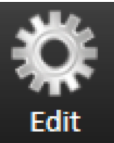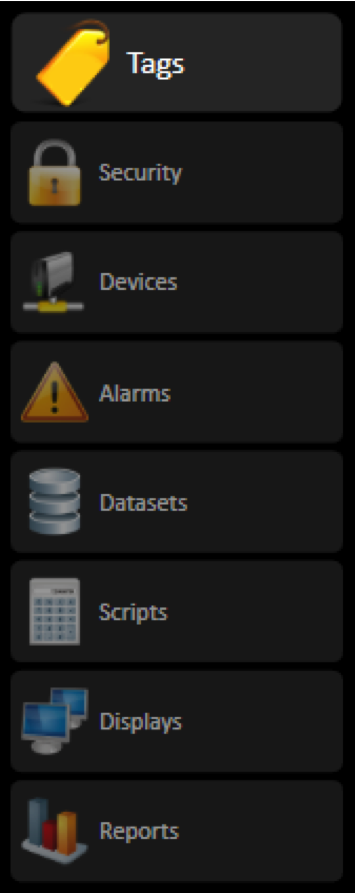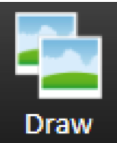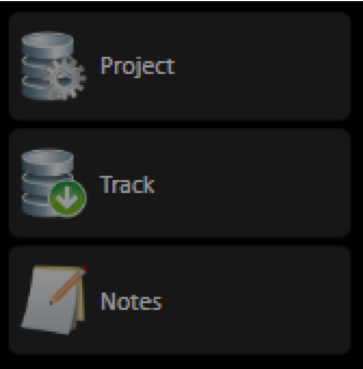The Engineering Workspace is a comprehensive display application that provides the tools and information you need to manage every aspect of FactoryStudio. The following sections explain the workspace and its various components:
Workspace Overview
The Engineering Workspace is accessed through the application TManager.exe. Once a selected project has been loaded, the user is provided with an interface similar to a web browser, with a back button, list of recent items, and other navigation tools. Figure 1 shows the main parts of the page.

You can drag the vertical bar with the mouse to adjust the size of the left menu frame, when you want to have more space on the workspace area. 
Using the Toolbar
.i.toolbar:using;
The toolbar at the top of every page has all of the common toolbar buttons, such as undo, redo, cut, copy, and paste, as well as buttons for common functions that are unique to FactoryStudio.

In addition, some buttons have additional options when you right-click them. For example, the Print and Find buttons have these additional options, as shown in Figure 2.

The print options let you either print or save to a CSV file.
The find options let you find, go to previous, and go to next. For more information, see Working with DataGrid Tables.
Undoing and Redoing Changes
.i.redo button;
.i.undo button;
The Undo and Redo buttons on the toolbar let you undo or redo any operation. When editing tables, undo and redo are available for all changes during your editing session.
When editing documents (in the Reports, and Scripts sections or in the Draw environment), undo and redo are available until you save changes.
Smart Cut, Copy and Paste
The Cut, Copy and Paste buttons are context sensitive. When the focus is on a DataGrid they will cut/copy and paste the selected rows. When the focus is on the drawing tool, they will act on the selected objects.
The reason for the word "Smart" is that you can copy and paste rows to and from Excel, as well from other tables in the workspace, even if the columns are not all the same. When copying and pasting, the column titles are also copied to the clipboard, so the system is able to put the information in the right columns, no matter what order the columns are in, and no matter if some columns are not present, in the target table.
When copying from Excel make sure to select the row titles. You can also copy rows from the Tags tables to the Historian directly to enable data logging of those tags.
Print, Save to a File or Import
 These commands allow you to print the selected document (either a DataGrid or a Drawing). The export button will save DataGrids to a CSV file and graphical displays to JPG files. The import button will import CSV files to the DataGrid.
These commands allow you to print the selected document (either a DataGrid or a Drawing). The export button will save DataGrids to a CSV file and graphical displays to JPG files. The import button will import CSV files to the DataGrid.
Finding Objects
.i.searching:for objects;
.i.finding:objects;
.i.objects:finding;
You may want to find where you have used a specific object, such as a tag, in a project. The Engineering workspace provides three ways to search.
 Find String button and Find Object Buttons
Find String button and Find Object Buttons
The Find String button is used to search for a specific string in the current tab of the current datagrid. Type the string you want to search for in the text box and press the FindString button.
The Find Object button on the toolbar accesses the object cross reference, which lets you find where objects are used in the Project and go directly to each location. For more information on cross reference, see Cross Reference under Productivity Tools.
![]()
Finally, you can filter the rows displayed on the datagrid by typing a mask string in the input field. Standard wildcards are supported. For example, if you set the filter to "abc" the display will show only the rows with the letters "abc" in any position of the name. A filter of "ab*" will show the rows with names starting with "ab". Click on the Home button to clear all the filters and reset the viewing state of all the datagrid columns to the system default.
New Tag and Tag Properties
![]()
New Tag: allows creation of a new tag in the real-time database.
Tag Properties: shows the properties of the tag selected in the text box.
Security Logon
![]() The tooltip shows the currently logged-in user and when you click it opens the Logon Dialog. By default, when the system starts, the Guest user is logged in. The permissions of each user are defined as explained in Security and Users.
The tooltip shows the currently logged-in user and when you click it opens the Logon Dialog. By default, when the system starts, the Guest user is logged in. The permissions of each user are defined as explained in Security and Users.
Help Button
![]() The Help button displays the section Info-Help, which provides access to the local help file and enables searches on the online content.
The Help button displays the section Info-Help, which provides access to the local help file and enables searches on the online content.
Navigating in the Workspace
.i.menus, using in FactoryStudio;
.i.navigating in FactoryStudio;
Navigation in the FactoryStudio workspace is based on a hierarchy of user interface screens with three levels: environments, sections (or modules) and tabs.

Any Engineering workspace user interface is, therefore, identified by 3 names: the Environment (main menu on top left), the Section (or sub-menu) and the Tab (or Table)
To describe how to get to a specific location where you perform functions, we use a shorthand notation.
For example, rather than saying:
Click Edit, then click Tags, then click the Objects tab.
We say:
Go to Edit > Tags > Objects.
This shorthand notation quickly tells you how to navigate to the correct main menu, section, and tab.
Environments
At the highest level, there are four environments: Edit, Draw, Run, and Info.

To configure the basic elements of your project, from the Main Menu, click on the "Edit" icon. This displays an index of all the main sections. They are:

Tags: define and edit tags to use in the project
Security: define user permissions and project access levels
Devices: configure communication protocols and device data acquisition.
Alarms: configure alarms and alarm groups to generate alarms under defined conditions
Datasets: define data sources such as files, databases, specific tables, Pre-defined queries.
Scripts: configure .NET Scripts in VB.NET or C-Sharp
Displays: select dynamic graphical displays to configure
Reports: configure reports, which include updated graphical symbols, in XPS, PDF, HTML, ASCII, and Unicode formats
.

The "Draw" icon allows you to configure dynamic displays. Select the Display on Edit-Displays and click on the Draw icon to access the graphic designer.
![]()
The Run environment provides access to all project execution commands. This environment displays an index as follows:

Build: prepare a project for execution and save the project's build history.
Test: test the project to see it in action before publishing it to the server for use.
Startup: run the project configuration in production mode.
Publish: publish the project to enable its final installation. Also increment the project Publish Revision numbers.
This environment also provides access to the following tools:
UseCount: tallies the number of times tags are used in the project. Provides the project object cross reference.
Localization: customize your project to use other languages in alarm messages and display text.
Extensions: import configuration data already created for OPC Servers, any configuration table, or an entire project.

The "Info" icon provides access to current project information in the following categories:

Project: project and product version, location of project, local language, license information.
Track: find information regarding the published project release number and project changes.
Notes: leave arbitrary notes for other project engineers.
Working with DataGrid Tables
Many tabs in FactoryStudio display information in a table. All tables let you manipulate, copy, paste, and import data in the same way. The following sections describe how to use these functions:
Editing Tables
.i.editing:tables;
.i.tables:editing;
FactoryStudio stores most configurations from the Edit menu, such as tags, alarms, and users, in tables. In most tables, you can add and edit information the same way.
To add a new table item (row):
![]()
After you click a column in the row, the * becomes a pencil icon, showing that you are now editing that row.
![]()
To edit an existing table row:
More than one person can edit a project at the same time. The system saves all changes to the project server and propagates the changes to other users. If two users modify the same configuration table or document, the changes from the last person who saves would overwrite any previous changes.
Tooltips and Validation
.i.validation, described;
.i.tooltips, using;
Throughout FactoryStudio, fields and buttons have tooltips that contain information about the field or button. tooltips appear when you move your cursor over the related field or button. Some tooltips also include an example that can help you.
The system also validates what you enter in most fields, especially in tables. Validation rules may check that the input is in a correct format, that values are within the appropriate range, and other factors. The exact rules depend on the specific item. If you see a red outline around the table cell, the entry is not valid.
Sorting, Filtering and Grouping
.i.grouping table information;
.i.filtering tables;
.i.sorting tables;
.i.tables:grouping information;
.i.tables:filtering;
.i.tables:sorting;
Information in many tabs within FactoryStudio displays in tables that you can sort, filter, and group.
By default, items in a table are listed in the order in which you created them.
To sort a table:

To filter a table:


To group items in a table:

Adding and Removing Columns
.i.removing:columns from tables;
.i.adding:columns to tables;
.i.columns:removing ;
.i.columns:adding;
.i.tables:removing columns;
.i.tables:adding columns;
Tables in FactoryStudio display a default set of columns. Every table has additional columns that you can display, and you can remove any of the default columns.
You can also change the order of the columns. For the definitions of columns that are available in all tables, see Common Column Definitions.
To add or remove a column:
Common Column Definitions
.i.columns:definitions for common;
.i.tables:common column definitions;
Several common columns are available from many tables. These columns are defined below, rather than repeating them in the description of every applicable table.
|
|
Column |
Description |
ID |
Database ID assigned to the object in the table. Numbers are assigned starting from 1 for the first object created and continue as needed. The IDs are unique only to a specific table. |
Level |
Select the level you want to associate with the tag on the Assets tab. See Creating Assets in the chapter Tags and Templates. |
Category |
Select one or more categories for this attribute. See Categories Dictionary below. |
DateModified |
Date the object was last changed. |
DateCreated |
Date the object was created. |
Description |
Enter a description of the object. |
Copying and Pasting Rows
.i.pasting rows;
.i.copying:rows;
.i.rows:copying and pasting;
.i.tables:copying and pasting rows;
You can copy and paste rows into and from tables in FactoryStudio. The smart copy/paste functions let you copy rows from one table to another within FactoryStudio. For example, you can copy tags and paste them into the Historian tab or the Items tab under Alarms.
You can also copy and paste to and from a spreadsheet.
In addition, you can import a comma-separated values (.csv) file into any table. Column headings must match the table you are importing into. The best way to ensure that is to copy rows into a spreadsheet first, then edit the spreadsheet.
Copying and Pasting Within FactoryStudio
To copy rows to another tab in FactoryStudio:
Copying and Pasting To or From a Spreadsheet
To copy rows to a spreadsheet:
To paste rows from a spreadsheet:
Importing Data
.i.data, importing;
.i.importing:data;
To import data:
The system imports the data into the table.
Productivity Tools
This section explains the major tools and features that are included in FactoryStudio to assist with common tasks. These include:
Intellisense
The Intellisense feature presents a list of valid objects according to the characters you are typing into a specific input field and the valid entries for that field. You can insert a selected item from that list by pressing enter, space, the dot key or other symbol keys. All the input fields, either on the datagrids or at the drawing tools, where you can use tag names or object names, are enabled through Intellisense.
The Intellisense fields also have built-in tooltips and validation, as previously discussed. Putting the mouse over a field will present the expected entries to that field. When you have an invalid input, the border of the field will become red and the tooltip will show the error.
Refactoring
Refactoring is the procedure of changing the definition of tag names, or any other object names (such as alarm groups, device nodes and any other) after that symbolic name is already in use in the application.
Thanks to the centralized SQL configuration, FactoryStudio allows you to rename any object by simply typing the new name at the configuration table where that object is defined. All the references to that object will remain valid, using the new name with no actions required.
For instance, to rename a tag that is already being used all across the project, just go to Edit-Tags-Objects and rename it. The same applies to Edit-Alarms-Groups, members at templates or any named object in the system.
Cross Reference
.i.tracking:object use;
.i.objects:tracking use of;
You can view how many times each object in the project is used, as well as a list of objects that are not used.
To find objects:
There are three distinct ways to select the object for which you want a cross reference.
To track object use:
The table lists the number of references to every object in the system.
To view objects that are not used, click the UnusedObjects tab.
For a complete cross-reference of all objects, click the CrossReference tab.
Dictionaries
This section presents various types of dictionaries that can be created and used in FactoryStudio. These include:
Localization
You can localize the text in your application in as many languages as needed. To do this, create a dictionary for each language.
To localize user interface text, be sure to select the Localizable option (Dynamics Configuration window, TextOutput options) for each display component that you need to localize.
To create a localization dictionary:
The alarm messages can also be included in the localization if the related check-box is set.
On Info-Project-Settings, you can also define the default Culture Information that the application is using. The runtime property Client.CultureInfo allows you to change it during runtime. Some display controls may get the Culture Info directly from the Operating System, so the correct procedure is to have both the Operating System setting and the project settings with the target culture to run the application.
Enumeration Sets
You can also use dictionaries to "translate" tag values to text. These dictionaries are called Enumeration Sets. For example, a device may have a value of 0 or 1
. Rather than display "0" or "1," you can display the strings "on" or "off."
To configure Enumeration sets:
Categories
You can create a dictionary of Categories in order to allow classification of engineering objects. Most configuration tables, such as Tags, Device Nodes, or Alarm Groups, have the Category column, where you can apply one or more categories to that object.
The object categories can also be accessed during runtime for filtering and other custom applications, from the Category property of the objects. A list of all categories defined in the Project is available during runtime at the property Server.Categories.
Import Wizards
On Run-Extensions-Import you can find a set of wizards to import project components.
The contents displayed at that interface are dynamically created according to the DLLs found in the IMPORT folder of the project installation.
System Integrators and other partner companies can create import wizards using the Toolkits.
The built-in Import tools installed with the product are:
Import FactoryStudio Projects:
Add the components of the selected project into the current project.
Import Rockwell ControlLogix
Creates the Tag Names, Tag Templates and does the mapping of the PLC addresses, all according to the information available at the L5K file.
Import OPC server configuration
Creates the Tag Names, Tag Templates and does the mapping of the OPC Client addresses, all according to the information available by browsing to the OPC server.
Import From OSIsoft PI System
When connecting with PI System Historian Servers, this wizard automatically creates the link with the tags, elements and attributes from PI AF servers.
When connecting with PI AF, the system automatically imports the definition of all templates and asset elements in the selected database, as well as the mapping to communicate with the server.
The Import PI wizard will only show on licensed installations with the PI Connection module enabled.
Importing XML tag templates
Creates tag names and tag templates according to the data structure of the XML file. This wizard also creates the Edit-Datasets-Files configuration to read that file.
Importing .NET classes from a DLL
Creates tag templates that matches the selected .NET classes.
Preferences
.i.configuring:preferences;
.i.preferences:configuring;
You can configure the FactoryStudio theme and other preferences.
To configure preferences:
Setting |
Description |
Theme |
Select the color scheme that you prefer in the engineering environment. The theme is also useful if you open the same project twice (once to edit and once to view information). You can apply a different theme to each window to distinguish them. |
Grid Fonts |
Click to see the fonts available for the user interface. Select the font family, typeface, and size, then click OK. |
Auto-save document |
Select how often you want the system to automatically save changes when editing scripts, using the drawing tools, and creating reports. |
Confirm on Build commands |
Select to display a confirmation window every time you build the project. |
Allow duplicate Tags on |
|
Help file location |
|